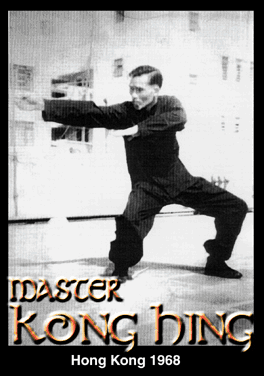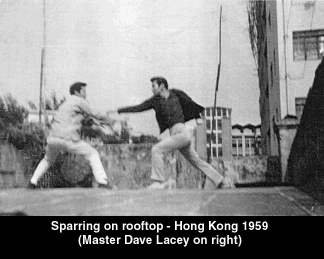|
 The
initial stage (first few weeks) of training were the toughest, but once
the aches and pain subsided Dave was able to more fully appreciate what
he was learning and began to spend more of his leisure time on his martial
arts training to improve the skills he acquired from his Sifu. The
initial stage (first few weeks) of training were the toughest, but once
the aches and pain subsided Dave was able to more fully appreciate what
he was learning and began to spend more of his leisure time on his martial
arts training to improve the skills he acquired from his Sifu.
Master Kong Hing
In the few months that followed was to see another
turning point in Dave's life. Master Lai Hung told Dave he could no
longer give him private tuition during the day because of a change in
his work shift with the Bus Company he was working for. Realizing that
Dave was not allowed out during weekday nights to attend kung fu classes
in the evenings at his school, Master Lai Hung made arrangements for
him to continue private training under a close Choy Lay Fut colleague
of his, a reputable fighter by the name of Kong Hing. Thus, began another
chapter in Dave's life as he began training under his new instructor
whose teachings and prowess as a kung fu fighter inspired and made Dave
even more determined to excel in Choy Lay Fut. The mutual liking and
respect they had for each other and Choy Lay Fut formed a very close
bond of friendship between the two- they became like blood brothers.
Whenever Dave was engaged in a challenge fight match with guys from
street gangs or rival martial arts schools, Kong Hing was always there
to watch the fights.
The Choy Lay Fut fighting techniques of Lai Hung and Kong
Hing were unique as both were from the Buck Sing branch of Choy
Lay Fut, a more dominantly combat oriented fighting arts developed
by the famous fighter and innovator of Choy Lay Fut, Master Tarm
Sarm. His experience in dueling matches with fighters of other
kung fu styles enabled Tarm to develop new fighting techniques
using the "charp chui" (panther fist) punch, which
became a trademark of Tarm Sarm and helped the name of Choy Lay
Fut to thunder throughout the whole middle of Southern China.
Out of the great respect they had for him, Tarm's students refer
to his innovative fighting art of Choy Lay Fut as "Buck
Sing Choy Lay Fut" as a tribute to his great reputation
and that of his school the Buck Sing Gwoon.
Learning Choy Lay Fut became a great passion for Dave and
he devoted much of his spare time on mastering the exciting and
dynamic moves and techniques Kong Hing had taught him. Though
Kong Hing was not officially his "Sifu", Dave looked
up to him as his new teacher and mentor. Kong Hing not only passed
on his superb martial arts skills to Dave but also his martial
arts philosphy and wisdom. As a martial arts instructor and spiritual
mentor, Kong Hing was instrumental in molding Dave into one of
the world's most famous and respected Choy Lay Fut masters of
the past five decades.
Although Dave was never really able to "officially"
call Kong Hing his Sifu, his overwhelming feeling of respect
and gratitude for his teacher and mentor compelled him to later
(1963) officially acknowledge Kong Hing as his Sifu for having
been the one responsible for teaching him most of his martial
arts knowledge and fighting skills. For Dave, it was a debt to
Kong Hing that he felt was long overdue.
Hong Kong's Street Gangs and Martial Arts Feuds
 People
take up martial arts for various reasons but for Dave it was predominantly
for self defense. Growing up as a teenager in the 1950's in Hong Kong
in an enviornment of antisocial tension he found himself a favorite
target for street confrontations and fights with hostile street gang
members or other individuals seeking a reputation for themselves as
tough guys. As he didn't belong to any street gang, Dave realized that
his only option was to learn the dynamic fighting art of Choy Lay Fut,
a style originally developed for warfare and therefore had to be both
practical and effective. It was not surprising that in the early 1960's
Bruce Lee told his students "Choy Lay Fut is the most effective
system I've seen for fighting more than one person and is one of the
most difficult styles to attack and to defend against" (quoted
in the book "Bruce Lee" by Jesse Glover in 1976). These and
other comments Bruce made back in 1958 in Hong Kong incited Dave to
learn Choy Lay Fut in early 1959. People
take up martial arts for various reasons but for Dave it was predominantly
for self defense. Growing up as a teenager in the 1950's in Hong Kong
in an enviornment of antisocial tension he found himself a favorite
target for street confrontations and fights with hostile street gang
members or other individuals seeking a reputation for themselves as
tough guys. As he didn't belong to any street gang, Dave realized that
his only option was to learn the dynamic fighting art of Choy Lay Fut,
a style originally developed for warfare and therefore had to be both
practical and effective. It was not surprising that in the early 1960's
Bruce Lee told his students "Choy Lay Fut is the most effective
system I've seen for fighting more than one person and is one of the
most difficult styles to attack and to defend against" (quoted
in the book "Bruce Lee" by Jesse Glover in 1976). These and
other comments Bruce made back in 1958 in Hong Kong incited Dave to
learn Choy Lay Fut in early 1959.
After the Communist takeover of China in 1949, many kung fu
masters were among the thousands of Nationalists who fled the
mainland to start a new life in the British Colony of Hong Kong.
With the surgence of many Chinese Martial Arts schools in the
1950's it was inevitable that challenges erupted between rival
fueding Kung Fu schools. As martial arts tournaments were outlawed
in the British Colony in the 50's and 60's, many young kung fu
students who were eager to test their fighting skills and defend
the name of their school and kung fu style engaged in secretly
held "challenge" or "grudge" matches against
martial artists of rival kung fu schools.
|